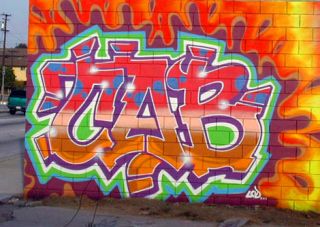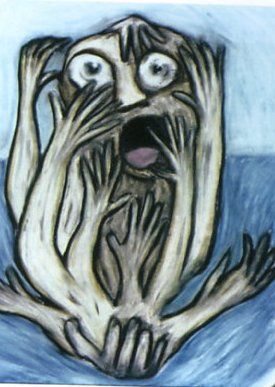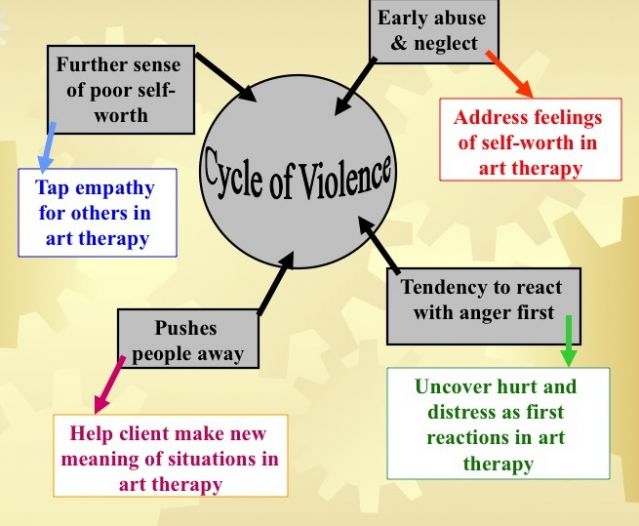
Anger
Drawing Out The Violence
5 reasons why art therapy is effective with violent and aggressive people
Posted October 8, 2013
"Art should cause violence to be set aside and it is only art that can accomplish this”
–Nikolai Tolstoy
Despite his small stature, Mike, a 15-year-old boy, was tough and quite strong. He was suspended from school for fighting and “acting out”, and was often in trouble with the law for gang activities. He was brought to the facility in which I worked. He believed himself “tougher” than all others, including staff. Rarely did a day go by where he did not try and attack a peer or a staff member for what he perceived to be disrespect, at times causing severe damage. This in turn required him to be restrained, validating his perception.
Proud of his gang, he “tagged” his gang name on all the walls. He became angry when the graffiti was removed from the walls, and at times attacked those who were cleaning up the drawings.
Because he received his identity and validation from his gang, through removing the graffiti, he was “told” he was unacceptable; once again the perceived disrespect resulting in violence.
Eventually, with permission from administration, I made a deal with Mike. I reiterated the rules of no graffiti and no public gang signs; however, if he agreed to work with me, he could draw his gang tags on separate paper and keep them in his drawer, if he promised not hang up the drawings. He reluctantly agreed. He spent several afternoons drawing quietly with pencil on white paper. Each drawing was meticulously completed with more detail as time progressed.
borrowed from the website http://pingmag.jp After completing several of these drawings, I then suggested that instead of illustrating his gang’s name, he do a drawing of his nickname given by his gang. Eventually, the drawing evolved into an embellishment of his real name. These he would show proudly, and these could be hung on his wall. By the time he was released, he was decidedly less aggressive.

borrowed from the website http://pingmag.jp
After completing several of these drawings, I then suggested that instead of illustrating his gang’s name, he do a drawing of his nickname given by his gang. Eventually, the drawing evolved into an embellishment of his real name. These he would show proudly, and these could be hung on his wall. By the time he was released, he was decidedly less aggressive.
Through this process, Mike accepted and validated. Simultaneously, his own concept of his true self was strengthened and he saw himself as an individual within a productive societal context rather than dependent on the illicit one, and his aggressive tendencies diminished.
Art provided an avenue for Mike to feel valued, provided a means of acceptable expression, and paved a way for him to develop and maintain a new sense of identity. His cycle of violence was interrupted through art (adapted from Gussak, 2006, 2007 & 2011).
During a recent book signing, I was asked a question that has been raised over the many years that I provided art therapy with aggressive and violent clients. I was asked if the 20 some-odd years that the defendant in the book Art on Trial spent making his own art prevented him from acting out violently prior to the murder. I must confess, I often pondered this myself.
Did the art keep him from acting out prior to the murder? If, perhaps, an art therapist was available to facilitate the process, could his more restrained behavior been sustained?

By prison inmate
I worked for many years with aggressive and violent people, including gang members, prison and jail inmates, juvenile justice detainees, and graduate students. Yet, some of the more violent people I worked with, who would have sooner cut me than talk, happily (or with at least begrudging willingness) picked up a marker or paintbrush to create; and, in doing so, they seemed transformed. This begs the question—does creative expression provide an outlet for violence and aggression?
Consolidated from a number of previous publications, I have summarized 5 ways art therapy may be effective with violent people.
[Please refer to the reference list below for additional resources on this topic].
- Art therapy takes advantage of the relationship between aggression and creativity
Dissanayake indicated, “…the impulse that drives some people to violence are the same impulses that drive the artist to create” (1988, p.139); aggression may be considered a positive force by many psychological theorists but only if the impulse is properly sublimated. This brings us to:
- Art therapy facilitates the catharsis and eventual sublimation of violent impulses
While initially the violent energy may emerge through cathartic expression, if such energy is redirected, focused, displaced and contained, the energy can be sublimated into a socially productive manifestation. As Kramer indicated, creative expression can be a by-product of sublimating aggressive impulses (1993).
- Art therapy provides one to express vulnerabilities, frustrations and irritations, even while not compelled to talk about them
Oftentimes, frustration may arise when a person is unable or unwilling to explain what he may be frustrated by, or perhaps he does not wish to disclose his vulnerabilities to avoid appearing weak. Art making allows the ‘disclosure’ and release of these feelings without having to have the ability or desire to put it into words.
- Art therapy offers a mechanism to re-label the individual
People are defined by their labels; negative ones may perpetuate violent identities (Bartusch & Matsueda, 1996); eventually, people “own” these identities.It is through re-labeling, (or reversing detrimental labels), validating new behaviors, and redefining actions of those seen as aggressive that such tendencies can be halted and perhaps reversed. Art-making may aide in developing appropriate interactions and creating new self-labels, in turn decreasing aggressive tendencies (Gussak, 2007). If their art is accepted, they are accepted. Thus…
- Art therapy can slow down the cycle of narcissistic rage
The art therapy process can strengthen one’s sense of self; provide an avenue to express negative emotions such as distress which may result in anger and aggression; create new meanings; and tap into empathic responses (Gussak, 2004; Gussak, Chapman, Rosal & Van Duinan, 2003). These, in turn, can reverse the narcissistic injury often associated with violent acts (please see accompanying diagram).

Diagram of Art Therapy with the Cycle of Violence, as developed by Gussak and Rosal
While other mitigating factors may be involved, including a possible mental illness or cognitive impairment, these 5 mechanisms provide the basis to understand how art making can facilitate change with such difficult clients.
Ultimately, I am not saying that engaging in the arts could prevent the many heinous and senseless violent acts demonstrated on what seems to be an almost daily basis, such as the Newton massacres, Naval base murders, Boston Marathon attacks, and the Aurora movie theater shootings. However, art making may provide an opportunity for productive self-expression, to sublimate violent impulses and to reverse a cycle of violence perpetuated by narcissistic rage, which may go a long way in helping stem the rising tide.
Addendum
**Something cool has developed; there is a contest through the website Goodreads.com, that is open from now until November 3, in which you can win one of two signed copies of the book Art on Trial, so be sure to enter—you can do so at: https://www.goodreads.com/giveaway/show/67586-art-on-trial-art-therapy-…
***I want to thank all of you who have contacted me via email, this blog and Facebook. I am now in the Twitter world, so I encourage you to follow me @davegussak.
References
Bartusch, D.J. and Matsueda, R.L. (1996). Gender, reflected appraisals, and labeling: A cross-group test of an interactionist theory of delinquency. Social Forces, 75(1), 145-176.
Dissanayake, E. (1988). What is art for? Seattle, WA: University of Washington Press.
Gussak, D. (2011). Art Therapy. In R.J.R. Levesque (ed.). The Encyclopedia of Adolescence (Vol. 1, pp. 166-175).New York, NY: Springer Science and Business Media.
Gussak, D. (2007). The deviant adolescent: Creating healthy interactions and re-labeling through art therapy. In D. B. Arrington (Ed.), Art, Angst and Trauma: Right Brain Interventions with Developmental Issues (pp. 132-149). Springfield, Ill: Charles C. Thomas, Publishers.
Gussak, D. (2006). Symbolic Interactionism, aggression and art therapy. In Frances Kaplan (Ed.), Art Therapy and Social Action (pp. 142-156). London: Jessica Kingsley, Publishers.
Kramer, E. (1993). Art as therapy with children (2nd ed.). Chicago, IL: Magnolia Street Publishers.



